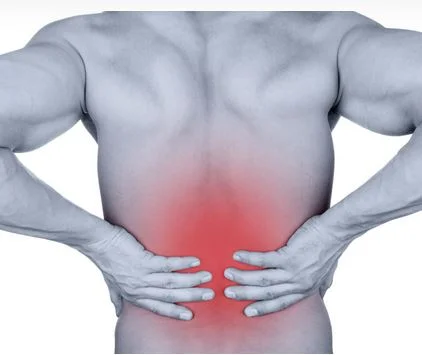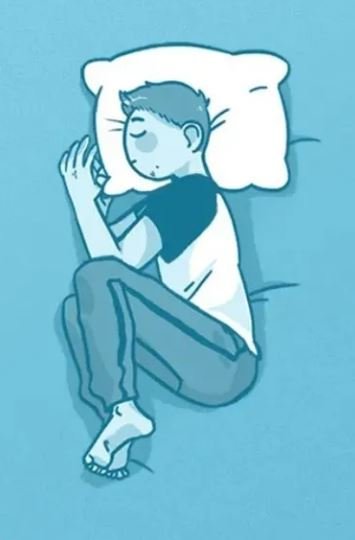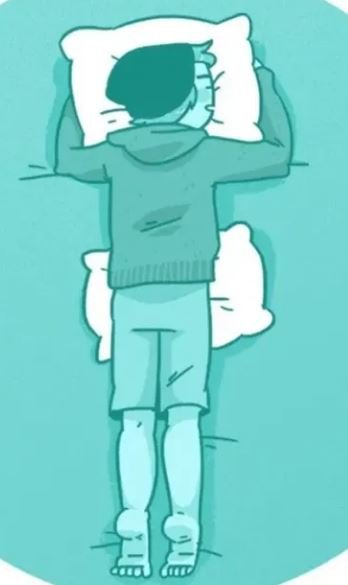
Best sleeping positions for low back pain patients
Low back pain is the number one cause of disability at work.
What’s more interesting is that most low back pain is not caused by serious malignant diseases, on the contrary, it is usually caused by bad posture, bad living habits, bad sleeping positions, etc. If you suffer from frequent low back pain, the following can provide you with the most suitable sleeping position, in addition,
there are some other measures you can take to get better sleep.
1. Sleep on your side with a pillow between your knee joints.
If lying on your back is uncomfortable, try lying on your side:
[Best sleeping positions for low back pain]

Let your right or left shoulder and the rest of your body make contact with the mattress.
Put a pillow between your knees.
If there is a gap between your lower back and the mattress, consider using small pillows for added support.
Whether you use one pillow or opt for two, avoid the habit of always sleeping on the same side. Doing so can lead to problems such as muscle imbalances and even scoliosis .
How does this pose help? Sleeping on your side won’t make you comfortable, but the benefit of this position is to utilize the pillow between your knees, which will keep your hips, pelvis, and spine in better alignment.
2. The fetus sleeps on its side2. The fetus sleeps on its side
If you have a herniated disc , you may want to try sleeping curled up on your side in the fetal position:

Lie flat on your back on the bed and roll gently to one side into a side-lying position.
Bend your knees toward your chest, and gently curl your torso toward your knees.
Remember to switch sides from time to time to prevent any imbalance.
How does this pose help? A disc is the spacer between the vertebrae of the spine. When part of the disc protrudes from the normal space, it can press on the nerve, causing neuralgia, leg numbness, etc. Curving your torso into fetal shape increases the space between the vertebrae.[Best sleeping positions for low back pain]
3. Lie on your stomach with a pillow on your abdomen
You may have heard that sleeping on your stomach is bad for lower back pain. This is partially true, as it may increase the stress on your cervical spine.

However, if you are used to sleeping on your stomach, you don’t have to force yourself to change your sleeping position, just make the following adjustments:
Place a pillow under your pelvis or lower abdomen to take pressure off your lower back.
Depending on how you feel about this sleeping position, you may choose to place a pillow under your head.
How does this pose help? People with degenerative disc disease may benefit more from this sleeping position. It relieves pressure on the intervertebral discs.
[Best sleeping positions for low back pain]
4. Lying supine and reclining
Does it feel very comfortable when you have a small dick on the recliner for a while? Although sleeping reclined in a chair may not be the best option for lower back pain, this position may help if you have isthmic spondylolisthesis.

For this type of patients, you can consider using an adjustable bed, so that you can adjust to the position that best suits your spine sequence and lumbar support to sleep.
How does this pose help? Isthmic spondylolisthesis is a pathological condition in which a vertebral body slips past its lower side. A recline may be beneficial for low back pain in this type of patient because it creates an angle between your thighs and torso. This angle helps reduce stress on the spine.
Remember: Spine Sequence Alignment is Key
No matter what sleeping position you choose, maintaining the proper alignment of your spine sequence is the most important key part. You may notice that the gap between your body and the bed creates a constant stretch on your muscles and strains your muscles. You can relieve this pressure by using pillows to fill in the gaps.
[Best sleeping positions for low back pain]
Matters needing attention in pillow selection
[Best sleeping positions for low back pain]
If you sleep on your back, the pillow should completely fill the gap between your cervical spine and the mattress. If you sleep on your side, try using a thicker pillow to keep your head in line with the rest of your body.
Regardless of your sleeping position, never put a pillow under your shoulders.
For back sleepers: Thinner pillows and pillows with extra padding on the bottom to support the cervical spine may be best.
Memory foam is a great material that can be molded to the proper shape of the pillow specifically for your cervical spine.
For stomach sleepers: You should try to use the thinnest possible pillow, or no pillow at all.
For side sleepers: You’ll want to look for a pillow with extra wide borders that will help fill the space between your ears and shoulders. And don’t forget to put a pillow between your knees.
While you’re at it, remember to replace your pillow every 18 months or so. There are many allergens on pillows that have been used for a long time, such as mold and dust mites.
[Best sleeping positions for low back pain]
Things to consider when choosing a mattress
Your mattress is also important.
Doctors used to recommend very firm mattresses to people with low back pain, but don’t rush into buying one just yet. Recent research has shown that people who use very firm mattresses may have poor sleep.
It has also been said that a mattress that is too soft does not help much with alignment of the spine.
So if you’re shopping for a mattress these days, try to choose a medium-firm mattress made of high-quality springs or foam . You can also add a memory foam mattress .
When buying a mattress at the store, it can be difficult to determine if it is actually comfortable after only a few minutes of testing it. Some companies will allow you to test the mattress for a set period of time, with the option to return it if it doesn’t work for you.
[Best sleeping positions for low back pain]
Other Sleep Tips
Here are some other ideas on how to get a better night’s rest and reduce lower back pain:
[Best sleeping positions for low back pain]
Schedule your own sleep: It can be difficult to fall asleep if you’ve been up all night . Still, setting a regular bedtime and wake-up time can help your body settle into a more natural sleep pattern. You need about eight hours of sleep each night.
Bedtime Routine: Try a nightly routine before bed. Begin this process about 30 to 60 minutes before your set bedtime. Choose two soothing activities that help bring your mind into a relaxing space.
Include bathing, doing some gentle yoga, and pursuing quiet hobbies such as reading or knitting.
Avoid caffeinated beverages: such as coffee and other stimulants, and if you do want to, do so by noon.
Avoid strenuous exercise before bed: Doing anything too exciting before bed can increase your adrenaline levels and even raise your body temperature. These two factors make sleeping more difficult.
Relief the pain
Before going to bed, you can use a hot water bottle for external application. It can help reduce inflammation in the lower back and relieve pain. Before going to bed, apply a hot water bottle to the waist for 15 to 20 minutes (for patients with acute injuries within 48 hours, it is recommended to use ice).
Insist on regular low back muscle exercises every day.
[Best sleeping positions for low back pain]
